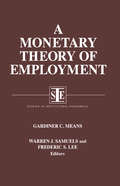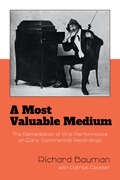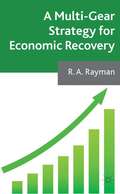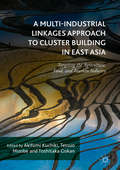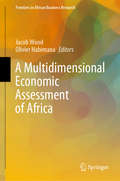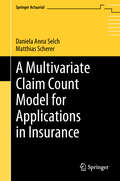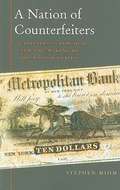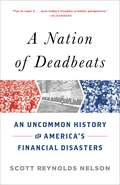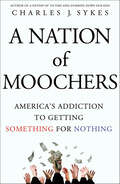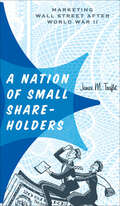- Table View
- List View
A Monetary Theory of Employment
by Warren J. Samuels Lily Xiao Lee Gardiner C. MeansPresents the author's alternative monetary theory and macroeconomics to both the quality theory and Keynes's work. This text reveals Means's view of the economic processes in the real world, and the state of monetary and macroeconomics theory in the mid-1940s.
A Monetary and Fiscal History of Latin America, 1960–2017
by Timothy J. Kehoe Juan Pablo NicoliniA major, new, and comprehensive look at six decades of macroeconomic policies across the region What went wrong with the economic development of Latin America over the past half-century? Along with periods of poor economic performance, the region&’s countries have been plagued by a wide variety of economic crises. This major new work brings together dozens of leading economists to explore the economic performance of the ten largest countries in South America and of Mexico. Together they advance the fundamental hypothesis that, despite different manifestations, these crises all have been the result of poorly designed or poorly implemented fiscal and monetary policies. Each country is treated in its own section of the book, with a lead chapter presenting a comprehensive database of the country&’s fiscal, monetary, and economic data from 1960 to 2017. The chapters are drawn from one-day academic conferences—hosted in all but one case, in the focus country—with participants including noted economists and former leading policy makers. Cowritten with Nobel Prize winner Thomas J. Sargent, the editors&’ introduction provides a conceptual framework for analyzing fiscal and monetary policy in countries around the world, particularly those less developed. A final chapter draws conclusions and suggests directions for further research.A vital resource for advanced undergraduate and graduate students of economics and for economic researchers and policy makers, A Monetary and Fiscal History of Latin America, 1960–2017 goes further than any book in stressing both the singularities and the similarities of the economic histories of Latin America&’s largest countries.Contributors: Mark Aguiar, Princeton U; Fernando Alvarez, U of Chicago; Manuel Amador, U of Minnesota; Joao Ayres, Inter-American Development Bank; Saki Bigio, UCLA; Luigi Bocola, Stanford U; Francisco J. Buera, Washington U, St. Louis; Guillermo Calvo, Columbia U; Rodrigo Caputo, U of Santiago; Roberto Chang, Rutgers U; Carlos Javier Charotti, Central Bank of Paraguay; Simón Cueva, TNK Economics; Julián P. Díaz, Loyola U Chicago; Sebastian Edwards, UCLA; Carlos Esquivel, Rutgers U; Eduardo Fernández Arias, Peking U; Carlos Fernández Valdovinos (former Central Bank of Paraguay); Arturo José Galindo, Banco de la República, Colombia; Márcio Garcia, PUC-Rio; Felipe González Soley, U of Southampton; Diogo Guillen, PUC-Rio; Lars Peter Hansen, U of Chicago; Patrick Kehoe, Stanford U; Carlos Gustavo Machicado Salas, Bolivian Catholic U; Joaquín Marandino, U Torcuato Di Tella; Alberto Martin, U Pompeu Fabra; Cesar Martinelli, George Mason U; Felipe Meza, Instituto Tecnológico Autónomo de México; Pablo Andrés Neumeyer, U Torcuato Di Tella; Gabriel Oddone, U de la República; Daniel Osorio, Banco de la República; José Peres Cajías, U of Barcelona; David Perez-Reyna, U de los Andes; Fabrizio Perri, Minneapolis Fed; Andrew Powell, Inter-American Development Bank; Diego Restuccia, U of Toronto; Diego Saravia, U de los Andes; Thomas J. Sargent, New York U; José A. Scheinkman, Columbia U; Teresa Ter-Minassian (formerly IMF); Marco Vega, Pontificia U Católica del Perú; Carlos Végh, Johns Hopkins U; François R. Velde, Chicago Fed; Alejandro Werner, IMF.
A Monetary and Fiscal History of the United States, 1961–2021
by Alan S. BlinderFrom the New York Times bestselling author, the fascinating story of U.S. economic policy from Kennedy to Biden—filled with lessons for todayIn this book, Alan Blinder, one of the world’s most influential economists and one of the field’s best writers, draws on his deep firsthand experience to provide an authoritative account of sixty years of monetary and fiscal policy in the United States. Spanning twelve presidents, from John F. Kennedy to Joe Biden, and eight Federal Reserve chairs, from William McChesney Martin to Jerome Powell, this is an insider’s story of macroeconomic policy that hasn’t been told before—one that is a pleasure to read, and as interesting as it is important.Focusing on the most significant developments and long-term changes, Blinder traces the highs and lows of monetary and fiscal policy, which have by turns cooperated and clashed through many recessions and several long booms over the past six decades. From the fiscal policy of Kennedy’s New Frontier to Biden’s responses to the pandemic, the book takes readers through the stagflation of the 1970s, the conquest of inflation under Jimmy Carter and Paul Volcker, the rise of Reaganomics, and the bubbles of the 2000s before bringing the story up through recent events—including the financial crisis, the Great Recession, and monetary policy during COVID-19.A lively and concise narrative that is sure to become a classic, A Monetary and Fiscal History of the United States, 1961–2021 is filled with vital lessons for anyone who wants to better understand where the economy has been—and where it might be headed.
A Month at the Brickyard: The Incredible Indy 500
by Sonny KleinfieldAn all-access pass to Pit Row and beyond at the world&’s most famous auto race, the Indianapolis 500The Indianapolis 500 auto race is the most prestigious event in all of motor sports. Race cars roar two hundred times around the track at dizzying speeds of more than two hundred miles per hour in front of a massive crowd—and millions more watching on television. Every spring, drivers, teams, sponsors, and pit crews all come together to make auto-racing history. Since the inaugural race in 1911, the Indy 500 has become one of the most popular sporting events in the world.Award-winning reporter Sonny Kleinfield takes readers inside the world of high-risk, high-speed open-wheel racing. A Month at the Brickyard follows the day-to-day race prep of Indy up-and-comer Johnny Parsons and team, showing the endless fine-tuning and customization up to the big day, as well as capturing the personalities and stories that surround the speedway. With Kleinfield at the wheel, there is much more to racing than just the roar of the engines.
A Moral Political Economy: Present, Past, and Future (Elements in Political Economy)
by Margaret Levi Federica CarugatiEconomies - and the government institutions that support them - reflect a moral and political choice, a choice we can make and remake. Since the dawn of industrialization and democratization in the late eighteenth century, there has been a succession of political economic frameworks, reflecting changes in technology, knowledge, trade, global connections, political power, and the expansion of citizenship. The challenges of today reveal the need for a new moral political economy that recognizes the politics in political economy. It also requires the redesign of our social, economic, and governing institutions based on assumptions about humans as social beings rather than narrow self-serving individualists. This Element makes some progress toward building a new moral political economy by offering both a theory of change and some principles for institutional (re)design.
A More Beautiful Life: A Simple Five-Step Approach to Living Balanced Goals with HEART
by Whitney EnglishA More Beautiful Life walks readers through setting HEART Goals, a proven framework that starts with helping you better understand yourself not by tracking and measuring everything to death but by meeting you right where you are. Traditional goal setting sets us up for failure. Starting from a place of desired outcomes, we attempt to answer the question, &“Where do I want to end up in life?&” Then we attempt to follow a plan that tells us to run in this direction and track our progress with journals, spreadsheets, and complicated tools. Often the plan is too long, too hard, and too elaborate. It&’s not flexible, fluid, or dynamic–in other words, nothing like real life. We focus too much on outcomes, letting the end justify the means, and often forget who we are in the process, missing the point of goal setting altogether. We need a system that allows us to embrace who we are and let that understanding guide us toward a better life. In A More Beautiful Life, Whitney English shares HEART Goals–a system that starts with what matters most to you, never forcing you to adopt arbitrary goals and rules. The process matters, not just the outcomes. This system frees you from comparison and allows you to be authentically yourself. It helps you gain confidence as you make the progress that comes from having done your best instead of the depressing discouragement that comes from comparing yourself to the performances of others. You won&’t have to become someone else to get what you want. H – Help YourselfE – Empower YourselfA – All Your PeopleR – Resources and ResponsibilitiesT – TradeThis is an integrative approach to help you create a more meaningful life that is all yours. You won&’t feel imbalanced or off-center as you pursue one area of success, fearing it will cost you somewhere else. Without any striving, your goals will be aligned with where you want to go in life. You won&’t need to completely change who you are to follow the system. No more deadlines. No more tracking. No more nonsense.
A More Beautiful Question: The Power of Inquiry to Spark Break Through Ideas
by Warren BergerTo get the best answer-in business, in life-you have to ask the best possible question. Innovation expert Warren Berger shows that ability is both an art and a science. <p><p> It may be the most underappreciated tool at our disposal, one we learn to use well in infancy-and then abandon as we grow older. Critical to learning, innovation, success, even to happiness-yet often discouraged in our schools and workplaces-it can unlock new business opportunities and reinvent industries, spark creative insights at many levels, and provide a transformative new outlook on life. It is the ability to question-and to do so deeply, imaginatively, and “beautifully.” <p> In this fascinating exploration of the surprising power of questioning, innovation expert Warren Berger reveals that powerhouse businesses like Google, Nike, and Netflix, as well as hot Silicon Valley startups like Pandora and Airbnb, are fueled by the ability to ask fundamental, game-changing questions. But Berger also shares human stories of people using questioning to solve everyday problems-from “How can I adapt my career in a time of constant change?” to “How can I step back from the daily rush and figure out what really makes me happy?” <p> By showing how to approach questioning with an open, curious mind and a willingness to work through a series of “Why,” “What if,” and “How” queries, Berger offers an inspiring framework of how we can all arrive at better solutions, fresh possibilities, and greater success in business and life.
A Most Valuable Medium: The Remediation of Oral Performance on Early Commercial Recordings
by Richard BaumanBetween 1895 and 1920, the United States saw a sharp increase in commercial sound recording, the first mass medium of home entertainment. As companies sought to discover what kinds of records would appeal to consumers, they turned to performance forms already familiar to contemporary audiences—sales pitches, oratory, sermons, and stories. In A Most Valuable Medium, Richard Bauman explores the practical problems that producers and performers confronted when adapting familiar oral genres to this innovative medium of sound recording. He also examines how audiences responded to these modified and commoditized presentations. Featuring audio examples throughout and offering a novel look at the early history of sound recording, A Most Valuable Medium reveals how this new technology effected monumental change in the ways we receive information.
A Moving Target: Real World Strategies for Applying 5 Forces, Selecting and Using Appropriate Tools, and Reacting to Feedback
by Jay Barney Patricia Gorman Clifford"What I Didn't Learn in Business School" follows new consultant Justin Campbell as he joins an elite team hired by a chemical firm to assess the potential of a newly developed technology. Read along as Justin meets with a vice president, the second-in-command at the chemical firm. Throughout the interview, Justin learns that a particular mode of analysis is not applicable to every situation. Like any newcomer, he tries to match a case study to a real-world situation-but business is not a science. In the real world, it's often difficult to distinguish the wrong from the right approach. Different strategies, as Justin learns, have advantages and disadvantages in different scenarios. In this chapter, authors Jay Barney and Trish Gorman Clifford demonstrate how to develop real-world strategies for applying the Five Forces framework, and for using feedback to your advantage. This chapter was originally published as Chapter 3 of "What I Didn't Learn in Business School: How Strategy Works in the Real World."
A Multi-Gear Strategy for Economic Recovery
by R. A. RaymanVolume II proposes radical reform (1) of the accounting system - to bring corporate management under the control of market forces; and (2) of the tax system - to enable the economy to grow to its full potential and to establish an automatic mechanism for price stability without any arbitrary intervention.
A Multi-Industrial Linkages Approach to Cluster Building in East Asia: Targeting the Agriculture, Food, and Tourism Industry
by Akifumi Kuchiki Tetsuo Mizobe Toshitaka GokanThis book proposes measures to promote regional industrial development in East Asia from the perspective of three industries: agriculture, food, and tourism. The authors argue that for regional agriculture to develop, collaboration with the food industry is essential. Further, by linking tourism, economic collaboration between the three industries is strengthened. The first part of the book introduces a basic model for the formation of the agriculture, food, and tourism industry cluster. Contributions from leading academics in agricultural economics then go on to discuss the relevance of this multi-industry cluster in countries such as Japan, the Republic of Korea, and Cambodia, amongst others. The final part sets out new approaches for further development in the cluster through quantitative analyses of the 'economies of sequence' concept. Readers will discover that from establishing linkages between different industries and other economic sectors, important positive externalities can be generated and these processes can be triggered on the local or cluster level.
A Multi-industry Model of Growth with Financing Constraints
by Anna Ilyina Roberto SamaniegoA report from the International Monetary Fund.
A Multidimensional Economic Assessment of Africa (Frontiers in African Business Research)
by Jacob Wood Olivier HabimanaThis book is a useful resource for government policy analysts, academics, students of higher education and business practitioners interested in African economies and the key economic issues these economies are facing in 2020. In the face of weak governance and growth globally, there is still a window of opportunity for countries in Africa to build on not only their traditional industrial capabilities, but also pave the way for positive developments in international trade and in the way governments tackle poverty and inequality. By focusing on four areas: (1) agriculture and livestock, (2) consumption, poverty and inequality, (3) financial services, employment and corporate governance, and (4) economic integration, international trade and foreign direct investment (FDI), this book presents a series of empirical studies that examine important contemporary economic issues facing Africa. The book incorporates a range of methodological approaches, with some chapters providing case study analyses while others embrace more traditional forms of econometric testing.
A Multivariate Claim Count Model for Applications in Insurance (Springer Actuarial)
by Matthias Scherer Daniela Anna SelchThis monograph presents a time-dynamic model for multivariate claim counts in actuarial applications. Inspired by real-world claim arrivals, the model balances interesting stylized facts (such as dependence across the components, over-dispersion and the clustering of claims) with a high level of mathematical tractability (including estimation, sampling and convergence results for large portfolios) and can thus be applied in various contexts (such as risk management and pricing of (re-)insurance contracts). The authors provide a detailed analysis of the proposed probabilistic model, discussing its relation to the existing literature, its statistical properties, different estimation strategies as well as possible applications and extensions. Actuaries and researchers working in risk management and premium pricing will find this book particularly interesting. Graduate-level probability theory, stochastic analysis and statistics are required.
A Multivariate Filter for Measuring Potential Output and the NAIRU: Application to the Czech Republic
by Papa N'Diaye Jaromir BenesA report from the International Monetary Fund.
A Narrative of Events, since the First of August, 1834, by James Williams, an Apprenticed Labourer in Jamaica
by James WilliamsThis book brings back into print, for the first time since the 1830s, a text that was central to the transatlantic campaign to fully abolish slavery in Britain's colonies. James Williams, an eighteen-year-old Jamaican "apprentice" (former slave), came to Britain in 1837 at the instigation of the abolitionist Joseph Sturge. The Narrative he produced there, one of very few autobiographical texts by Caribbean slaves or former slaves, became one of the most powerful abolitionist tools for effecting the immediate end to the system of apprenticeship that had replaced slavery. Describing the hard working conditions on plantations and the harsh treatment of apprentices unjustly incarcerated, Williams argues that apprenticeship actually worsened the conditions of Jamaican ex-slaves: former owners, no longer legally permitted to directly punish their workers, used the Jamaican legal system as a punitive lever against them. Williams's story documents the collaboration of local magistrates in this practice, wherein apprentices were routinely jailed and beaten for both real and imaginary infractions of the apprenticeship regulations. In addition to the complete text of Williams's original Narrative, this fully annotated edition includes nineteenth-century responses to the controversy from the British and Jamaican press, as well as extensive testimony from the Commission of Enquiry that heard evidence regarding the Narrative's claims. These fascinating and revealing documents constitute the largest extant body of direct testimony by Caribbean slaves or apprentices.
A Nation Divided: The United States and the Challenge of Secession
by David A. Moss Marc CampasanoAmericans elected Abraham Lincoln as the nation's first Republican president in November of 1860. Northern political leaders had formed the Republican Party only a few years before, in large measure to combat the spread of slavery. Southerners had long been wary of Northern hostility toward their "peculiar institution," and Lincoln's 1860 victory proved to be the last straw in this sectional rivalry that had deeply influenced American culture and politics since the earliest days of the republic. By the time of Lincoln's inauguration five months later, in March 1861, seven Southern states had announced their decision to secede from the Union. Lincoln rejected secession as unlawful and pledged that his government would continue to exercise its authority, as best it could, in the rebellious states. A crisis in South Carolina, the first state to secede, tested Lincoln's mettle in the opening days of his presidency. Federal troops still held Fort Sumter in Charleston harbor, but their supplies were running low. Lincoln would either have to evacuate the fort or risk war by sending provisions. The new president understood the weight of the choice he faced: nothing less than the survival of the Union was at stake.
A Nation of Counterfeiters: Capitalists, Con Men, and the Making of the United States
by Stephen MihmListen to a short interview with Stephen MihmHost: Chris Gondek | Producer: Heron & Crane Few of us question the slips of green paper that come and go in our purses, pockets, and wallets. Yet confidence in the money supply is a recent phenomenon: prior to the Civil War, the United States did not have a single, national currency. Instead, countless banks issued paper money in a bewildering variety of denominations and designs--more than ten thousand different kinds by 1860. Counterfeiters flourished amid this anarchy, putting vast quantities of bogus bills into circulation. Their success, Stephen Mihm reveals, is more than an entertaining tale of criminal enterprise: it is the story of the rise of a country defined by a freewheeling brand of capitalism over which the federal government exercised little control. It was an era when responsibility for the country's currency remained in the hands of capitalists for whom "making money" was as much a literal as a figurative undertaking. Mihm's witty tale brims with colorful characters: shady bankers, corrupt cops, charismatic criminals, and brilliant engravers. Based on prodigious research, it ranges far and wide, from New York City's criminal underworld to the gold fields of California and the battlefields of the Civil War. We learn how the federal government issued greenbacks for the first time and began dismantling the older monetary system and the counterfeit economy it sustained. A Nation of Counterfeiters is a trailblazing work of history, one that casts the country's capitalist roots in a startling new light. Readers will recognize the same get-rich-quick spirit that lives on in the speculative bubbles and confidence games of the twenty-first century.
A Nation of Deadbeats: An Uncommon History of America's Financial Disasters
by Scott Reynolds NelsonThe story of America is a story of dreamers and defaulters. It is also a story of dramatic financial panics that defined the nation, created its political parties, and forced tens of thousands to escape their creditors to new towns in Texas, Florida, and California. As far back as 1792, these panics boiled down to one simple question: Would Americans pay their debts--or were we just a nation of deadbeats? From the merchant William Duer's attempts to speculate on post-Revolutionary War debt, to an ill-conceived 1815 plan to sell English coats to Americans on credit, to the debt-fueled railroad expansion that precipitated the Panic of 1857, Scott Reynolds Nelson offers a crash course in America's worst financial disasters--and a concise explanation of the first principles that caused them all. Nelson shows how consumer debt, both at the highest levels of finance and in the everyday lives of citizens, has time and again left us unable to make good. The problem always starts with the chain of banks, brokers, moneylenders, and insurance companies that separate borrowers and lenders. At a certain point lenders cannot tell good loans from bad--and when chits are called in, lenders frantically try to unload the debts, hide from their own creditors, go into bankruptcy, and lobby state and federal institutions for relief. With a historian's keen observations and a storyteller's nose for character and incident, Nelson captures the entire sweep of America's financial history in all its utter irrationality: national banks funded by smugglers; fistfights in Congress over the gold standard; and presidential campaigns forged in stinging controversies on the subject of private debt. A Nation of Deadbeats is a fresh, irreverent look at Americans' addiction to debt and how it has made us what we are today.
A Nation of Farmers
by Sharon Astyk Aaron Newton"Astyk and Newton have written an important book with an unusual message: We need millions of new farmers...as soon as possible. You could not find two more reasonable, intelligent, sincere, and passionate people to talk to about food. And the book has very much the feeling of a conversation - with someone smart who cares about you. It is also intellectually complex, creative and nuanced. The authors are big thinkers and have taken a good lick at the central human issues of our time." Peter Bane "This definitive guide can provide inspiration to gardeners and those concerned about the environment. It offers practical solutions to all the food-related problems brought on by industrialized agriculture and the globalization of food. Very carefully researched and well written, this documents what is wrong and what we can do about it." Connie Krochmal - Bellaonline "This outstanding and well-written compendium of insights and recommendations, of fervent idealism and practical solutions, is highly recommended."--Library Journal Once we could fill our grocery carts with cheap and plentiful food, but not anymore. Cheap food has gone the way of cheap oil. Climate change is already reducing crop yields worldwide. The cost of flying in food from far away and shipping it across the country in refrigerated trucks is rapidly becoming unviable. Cars and cows increasingly devour grain harvests, sending prices skyrocketing. More Americans than ever before require food stamps and food pantries just to get by, and a worldwide food crisis is unfolding, overseas and in our kitchens. We can keep hunger from stalking our families, but doing so will require a fundamental shift in our approach to field and table. A Nation of Farmers examines the limits and dangers of the globalized food system and shows how returning to the basics is our best hope. The book includes in-depth guidelines for: Creating resilient local food systems Growing, cooking, and eating sustainably and naturally Becoming part of the solution to the food crisis The book argues that we need to make self-provisioning, once the most ordinary of human activities, central to our lives. The results will be better food, better health, better security, and freedom from corporations that don't have our interests at heart. This is critical reading for anyone who eats and cares about high-quality food. Sharon Astyk farms in New York, and is the author of Depletion and Abundance. Aaron Newton is a sustainable systems land planner in North Carolina, and is the founding editor of Groovy Green.
A Nation of Moochers: America's Addiction to Getting Something for Nothing
by Charles J. SykesWe have experienced a shift in American character: we've become a nation of moochers. Increasingly dependent on the efforts of others over our own, Americans are free to freeload. From the corporate bailouts on Wall Street to the alarming increases in personal default and dependency, from questionable tax exemptions to enormous pension, healthcare, and other entitlement costs, the new moocher culture cuts across lines of class, race, and private and public sectors. And the millions that plan and behave sensibly, only to bail out the profligate? They're angry.Charles Sykes' argument is not against compassion or legitimate charity, but targets the new moocher culture, in which self-reliance and personal responsibility have given way to mass grasping after handouts. A Nation of Moochers is a persuasively argued and entertaining rallying cry for Americans who are tired of playing by the rules and paying for those who don't.
A Nation of Realtors®: A Cultural History of the Twentieth-Century American Middle Class
by Jeffrey M. HornsteinHow is it that in the twentieth century virtually all Americans came to think of themselves as "middle class"? In this cultural history of real estate brokerage, Jeffrey M. Hornstein argues that the rise of the Realtors as dealers in both domestic space and the ideology of home ownership provides tremendous insight into this critical question. At the dawn of the twentieth century, a group of prominent real estate brokers attempted to transform their occupation into a profession. Drawing on traditional notions of the learned professions, they developed a new identity--the professional entrepreneur--and a brand name, "Realtor. " The Realtors worked doggedly to make home ownership a central element of what became known as the "American dream. " Hornstein analyzes the internal evolution of the occupation, particularly the gender dynamics culminating in the rise of women brokers to predominance after the Second World War. At the same time, he examines the ways organized real estate brokers influenced American housing policy throughout the century. Hornstein draws on trade journals, government documents on housing policy, material from the archives of the National Association of Realtors and local real estate boards, demographic data, and fictional accounts of real estate agents. He chronicles the early efforts of real estate brokers to establish their profession by creating local and national boards, business practices, ethical codes, and educational programs and by working to influence laws from local zoning ordinances to national housing policy. A rich and original work of American history, A Nation of Realtors illuminates class, gender, and business through a look at the development of a profession and its enormously successful effort to make the owner-occupied, single-family home a key element of twentieth-century American identity.
A Nation of Small Shareholders: Marketing Wall Street After World War II (Studies in Industry and Society)
by Janice M. TrafletThe little-known story of Wall Street’s effort to court individual investors during the Cold War in order to build a bulwark against communism.Immediately after the frightening Great Crash of 1929, many Americans swore they would never—or never again—become involved in the stock market. Yet hordes of Americans eventually did come to embrace equity investing, to an extent actually far greater than the level of popular involvement in the market during the Roaring Twenties. A Nation of Small Shareholders explores how marketers at the New York Stock Exchange during the mid-twentieth century deliberately cultivated new individual shareholders.Janice M. Traflet examines the energy with which NYSE leaders tried to expand the country’s retail investor base, particularly as the Cold War emerged and then intensified. From the early 1950s until the 1970s, Exchange executives engaged in an ambitious and sometimes controversial marketing program known as “Own Your Share of America,” which aimed to broaden the country’s shareholder base. The architects of the marketing program ardently believed that widespread share ownership would strengthen “democratic capitalism”—which, in turn, would serve as an effective barrier to the potential allure of communism here in the United States.Based on extensive primary source research, A Nation of Small Shareholders illustrates the missionary zeal with which Big Board leaders during the Cold War endeavored to convince factions within the Exchange, as well as the public, of the practical and ideological importance of building a true shareholder nation.
A Nation of Small Shareholders: Marketing Wall Street after World War II (Studies in Industry and Society)
by Janice M. TrafletHow New York Stock Exchange leaders in the decades after the Great Crash of 1929 helped popularize equity investing.Immediately after the frightening Great Crash of 1929, many Americans swore they would "never" or "never again" become involved in the stock market. Yet hordes of Americans eventually did come to embrace equity investing, to an extent actually far greater than the level of popular involvement in the market during the Roaring 1920s. A Nation of Small Shareholders explores how marketers at the New York Stock Exchange during the mid twentieth century deliberately cultivated new individual shareholders.Janice M. Traflet examines the energy with which NYSE leaders tried to expand the country’s retail investor base, particularly as the Cold War emerged and then intensified. From the early 1950s until the 1970s, Exchange executives engaged in an ambitious and sometimes controversial marketing program known as "Own Your Share of America," which aimed to broaden the country’s shareholder base. The architects of the marketing program ardently believed that widespread shareownership would strengthen "democratic capitalism" which, in turn, would serve as an effective barrier to the potential allure of communism here in the United States.Based on extensive primary source research, A Nation of Small Shareholders illustrates the missionary zeal with which Big Board leaders during the Cold War endeavored to convince factions within the Exchange as well as the outside public of the practical and ideological importance of building a true shareholder nation.In these troubled economic times, every citizen should welcome studies that shed light on U.S. financial markets. A Nation of Small Shareholders puts the role of individual investors in broader, long-term perspective.
A Nation's Paper: The Globe and Mail in the Life of Canada
by John IbbitsonFrom Canada's newspaper of record for 180 years, here are thirty-one brilliant and provocative essays by a diverse selection of their writers on how The Globe and Mail covered and influenced major events and issues from the paper&’s founding to the latest file. Since 1844, the Globe and Mail and its predecessor, George Brown&’s Globe, have chronicled Canada: as a colony, a dominion, and a nation. To mark the paper&’s 180th anniversary, Globe writers explored thirty issues and events in which the national newspaper has influenced the course of the country: Confederation, settler migrations, regional tensions, tussles over language, religion, and race. The essays reveal a tapestry of progress, conflict, and still-incomplete reconciliation: Catholic-Protestant hostilities that are now mostly the stuff of memory; the betrayal of Indigenous peoples with which we still grapple; the frustrations and triumphs of women journalists; pandemics old and new; environmental challenges; the joys of covering sports and the arts; chronicling the nation&’s business, international coverage, the impossibility of Canada and of this newspaper, which both somehow flourish nonetheless. Riveting, insightful, disturbing, witty, and always a joy to read, A Nation&’s Paper chronicles a country and a newspaper that have grown and struggled together – essential reading for anyone who wants to understand where we came from and where we are going. The Globe and Mail will donate all its proceeds from the book to Journalists for Human Rights.
